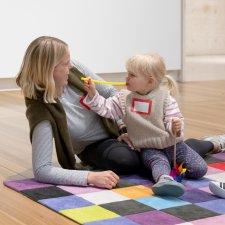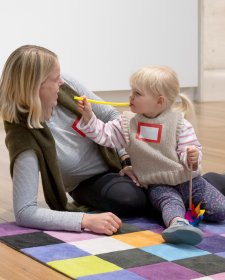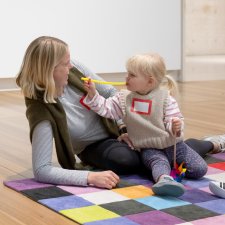Australian surfing legend Mark Richards describes his professional surfing and surfboard shaping careers.
This video was produced with funds donated by Tim Fairfax AC.
Australian surfing legend Mark Richards describes his professional surfing and surfboard shaping careers.
This video was produced with funds donated by Tim Fairfax AC.
Mark Richards: Well, I was... my kind of expression is, I was born into a, "No choice, you’re going surfing, son" family, because my mum and dad both surfed, and my dad was one of the first guys to actually start surfing in Newcastle. I think it was one day at Bar Beach, which is just up the road from where we are now, he saw a guy with a surfboard, and thought, "That looks like fun." And he inquired as to where the guy had bought the board, because at the time he’d never seen anyone surfing in Newcastle. So the guy had bought it either from Barry Bennett or Gordon Woods in Sydney, who were the two first surfboard manufacturers in Australia. And this was back in the 1950's. And he actually got an idea to start buying a few and open a surf shop in Newcastle. And at that stage, he had a showroom and he was selling used cars. So when the surfing thing sort of took over, the shop that he was running went from selling, you know, cars, to selling cars and surfboards.
There was no actual point where I decided I wanted to be a pro surfer. What happened was, the first events that I started surfing in were the Newcastle under-14’s schoolboy events. And I enjoyed competing, because I sort of liked winning trophies. That was about the only motivation, really. You know, I enjoyed the, putting on the singlet and paddling out, and you know, that challenge of, you know, trying to being able to surf really well, and get good rides in 20 minutes. And then if you did good, you know, you won a trophy at the end of the event.
My chosen career path when I left school was, I wanted to be a surfboard shaper, 'cause I was riding boards shaped by Geoff McCoy, who was a Sydney surfboard manufacturer, and I used to spend a lot of my school holidays in Sydney staying with Geoff. So Geoff sort of taught me the basics of surfboard shaping. And I was, like, learning how to shape, and then I was competing just selectively in the countries I liked competing in. It was mainly in the Australian events, because it didn't involve very much travel. See, everyone was riding single-fin surfboards, and most of the events were held in small surf. And a single-fin surfboard has a really narrow tail with a big fin. So what would happen was, because the tail was narrow, it used to sink on small waves; it didn't have a lot of get up and go. But the tail had to be narrow, because if you made the tail wider, what would happen is, when you turn the board, because of the width of the tail, it wouldn't hold into the wave face and it would just sort of slide out, and you’d just fall sort of face-first into the water.
Surfboards with two fins had been around in the early '70's, but they didn't go very good. So I got the idea of trying to combine, you know, the best aspects of the single fin with what I’d remembered about surfing the twin-fin from those sort of earlier years. So I managed to kind of come up with a package that sort of worked the first time, I got it right the first time, which was a bit of a miracle; but it was just an effort to try and get, you know, a happy medium between the two boards. The bar was actually lifted as to what you could actually do on a wave, how hard you could turn, you know, how vertically you could hit the top of the wave. And it was sort of the springboard for all my, you know, major competitive success which really started to accelerate from 1978 onwards. It was sort of a crossroads thing, where I was, like, the surfboard shaping business was going well, and I was manufacturing boards, and I thought that that was where my career sort of lay.
And then coming into the last two events of the year in Hawaii, which at that stage I was competing in the Hawaiian events - and I had in 1977 and ’78 - I was in... I’d slipped back to fourth in the ratings, even not doing the middle part of the tour. And then the first event was Pipeline, and I got a fourth place finish in that, which sort of kept me in fourth in the ratings. And then the last event was the World Cup, which was held at a spot called Haleiwa. And for me to win the World Title, I had to win the event, but three other things had to happen on the way to winning the event.
So Wayne "Rabbit" Bartholomew, who was the current World Champ, he had to lose in the first round, which he hadn't done all year. Which happened - he lost to a wildcard surfer. Dane Kealoha, who was in third, had to lose in the quarter finals, which he did to a young guy from Puerto Rico who was also a wildcard, in one of the first events he’d surfed in. And then Cheyne Horan, who was in second in the ratings, had to lose to Peter Townend in the semi-finals, which he did. And I don't think Peter had beaten Cheyne all year. And then I had to win the final to win the World Title. So it was, there was no kind of pressure on the day, because I thought just winning an event is hard enough, but to actually win an event and have all these other scenarios play out is kind of really hard. So it turned out I sort of won, surprisingly, and basically thought, "Shit, this is pretty cool," you know. Winning the World Title, and then, you know, the best professional surfer in the world - "This is awesome; I’m going to try and win again, because no one’s ever won the title twice."
So it was kind of a completely different career shift; the surfboard shaping went onto the backburner, and then I concentrated on trying to win my second World Title, and then my third and fourth World Title, which sort of happened. And then after winning four of them, I was sort of probably a bit mentally and physically burnt out on doing the tour and all the traveling. And again, the sponsorship money was still really low, and there wasn't really very much prize money. So there was no kind of end to the career path with that; it was like, you just, you kept going, and you got to a point where young guys eventually retired you and you’re on the scrapheap, and then you’re scratching your head, going, "What do I do for the rest of my life?" So after the fourth one in '82, I went back to concentrating on shaping surfboards again, which I’d sort of done for those four years, but hadn't... you know, all my effort had sort of gone into competitive surfing. I think, you know, what ends up being important is pretty much, you know, sort of how you've lived your life and how you've treated people, and you know, friends, family, and you know, wives and kids; and they become, you know, what’s important and what your life, you end up focusing your life on, you know. Sort of surfing contests all seem a little bit silly when you analyse them 35 years later.



Drop into the Gallery any time for free creative activities inspired by artist Thom Roberts and his exhibition, The Immersive World of Thom Roberts.



Join us for Portrait Play these school holidays as we explore portraits and music. Come and meet the people that live on our walls, discover musical instruments hidden in the portraits and get creative on your journey through the galleries.



Do we have a treat for the smaller humans in your life! Little Faces is for babies and toddlers (with their grown up) to play, sing and have fun discovering a portrait together.